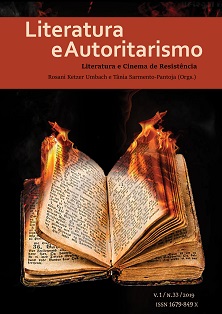Gewaltherrschaft in Argentinien: Eine beispielhafte Analyse der Darstellung von Gewalt in Garaje Olimpo
DOI:
https://doi.org/10.5902/1679849X35155Keywords:
Representação da violência, Ditadura militar, Não-exposição, Argentina, Terrorismo de EstadoAbstract
Im Zuge erinnerungspolitischer Bestrebungen thematisiert Marco Bechis in seinem Film Garaje Olimpo Folter und Verschleppung während der argentinischen Militärdiktatur. Garaje Olimpo handelt von María Fabiani, einer jungen Frau, die mit ihrer Mutter in einem Haus in Buenos Aires lebt. Sie wird von ihrem Mitbewohner, einem Militärpolizisten, in das Geheimgefängnis Garaje Olimpo verschleppt, dort gefoltert und anschließend umgebracht. Die Analyse beruht auf einem breiten Gewaltbegriff, der unter anderem Unterdrückung umfasst und Zerstörung als Ziel hat. Sie zeigt auf narrativer, gestalterischer und musikalischer Ebene die differenzierten Darstellungen physischer und psychischer bzw. indirekter Gewalt. Auf narrativer Ebene arbeitet Bechis mit Elementen der Vorhersehung, mit Gegensätzen von Licht und Dunkelheit und mit Distanz und Nähe in Szenen physischer Gewalt. Das daraus resultierende Nicht-zeigen der Gewalt, macht Garaje Olimpo zu einem Film des Unbehagens.Downloads
References
ABREGO, V. A. Erinnerung und Intersektionalität: Frauen als Opfer der argentinischen Staatsrepression (1975-1983): transcript Verlag, 2016.
AGUILAR, G. New Argentine film. New concepts in Latino American cultures. New York, NY [u.a.]: Palgrave Macmillan, 2011.
AMAR SÁNCHEZ, A. M.; AVILÉS, L. F. Prólog/Presentación. In A. M. Amar Sánchez; L. F. Avilés (Eds.). Nexos y diferencias: Vol. 44. Representaciones de la violencia en América Latina. Genealogías culturales formas literarias y dinámicas del presente Madrid: Iberoamericana, 2015, S. 9-21.
BEE, J. Folter und die Grenzen des Humanen. Zu einigen aktuellen und historischen Konfigurationen von Folter und Film. In K. Altenhain, R. Gorling, & J. Kruse (Eds.), Die Wiederkehr dr Folter? Interdisziplinare Studien Uber Eine Extreme Form Der Gewalt, Ihre Mediale Darstellung Und Ihre Achtung. V&R unipress, 2012, S. 165-226.
BENJAMIN, W. Zur Kritik der Gewalt. In W. Benjamin & H. Marcuse (Eds.), Zur Kritik der Gewalt und andere Aufsätze. 13th ed., Frankfurt am Main: Suhrkamp, 2015, S. 29-65.
BLOCH, N. Legitimierte Gewalt: Zum Verhältnis von Sprache und Gewalt in Theatertexten von Elfriede Jelinek und Neil LaBute: transcript Verlag, 2014.
DUBOIS, P. Torture and Truth (Routledge Revivals): Taylor & Francis, 2016.
FLYNN, M.; SALEK, F. F. Screening Torture: An Introduction. In M. Flynn; F. F. Salek (Eds.). Screening torture. Media representations of state terror and political domination. New York: Columbia University Press, 2012, S. 1-18.
GÖRLING, R. Szenen der Gewalt: Folter und Film von Rossellini bis Bigelow. Medien - Kultur - Analyse: Vol. 7. Bielefeld: Transcript, 2014.
HICKETHIER, K. Film- und Fernsehanalyse. 4., aktualisierte und erw. Aufl.. Stuttgart [u.a.]: Metzler, 2007.
JELIN, E. The Past in the Present: Memories of State Violence in Contemporary Latin America. In: A. Assmann (Ed.). Palgrave Macmillan memory studies. Memory in a global age. Discourses practices and trajectories. Basingstoke [u.a.]: Palgrave Macmillan, 2010, S. 61-78.
KAMINSKY, A. Marco Bechis' Garage Olimpo: Cinema of witness. Jump Cut: A Review of Contemporary Media, winter (48), 2006. Retrieved from https://www.ejumpcut.org/archive/jc48.2006/GarageOlimpo/text.html
KEPPLER, A. Mediale Gegenwart: Eine Theorie des Fernsehens am Beispiel der Darstellung von Gewalt. Suhrkamp-Taschenbuch Wissenschaft: Vol. 1790. Frankfurt am Main: Suhrkamp, 2006.
KING, J. Magical Reels: A History of Cinema in Latin America: Verso. In: Mikos, L. Film- und Fernsehanalyse. UTB: 2415: Medien- und Kommunikationswissenschaft, Literaturwissenschaft. Konstanz: UVK-Verl.-Ges, 2000.
MIKOS, Lothar. Ästhetik der Gewaltdarstellung in Film und Fernsehen : Genrespezifik und Faszination für Zuschauer. TV-Diskurs : Verantwortung in Audiovisuellen Medien, 2001, 16. Ministerio de Educación de la Nación. Canción a la Bandera: (De la Ópera Aurora). Retrieved from http://www2.me.gov.ar/efeme/20dejunio/cancancion.html 29
NATTER, A. Die filmische Darstellung der argentinischen Diktatur (Diplomarbeit). Universität Wien, Wien, 2010. Retrieved from http://othes.univie.ac.at/11408/1/2010-09- 16_0347099.pdf
PAGANI, A. (Producer). & Bechis, M. (Director). Junta. Garage Olimpo: Garaje Olimpo, 1999.
ROBBEN, A. Vom Schmutzigen Krieg zum Völkermord: Argentiniens wechelvolle Erinnerung an eine gewalttätige Vergangenheit. In E. Halbmayer & S. Karl (Eds.), Global Studies. Die erinnerte Gewalt. Postkonfliktdynamiken in Lateinamerika. Bielefeld: Transcript, 2012, S. 31-56.
SCARRY, E. The Body in Pain: The Making and Unmaking of the World: Oxford University Press, 1985. Retrieved from https://books.google.de/books?id=NEaz8I0KAk4C
SHAW, D. Contemporary Latin American Cinema: Breaking into the Global Market: Rowman & Littlefield Publishers, 2007.
VIEIRA, P. Seeing Politics Otherwise: Vision in Latin American and Iberian Fiction. Toronto: University of Toronto Press, 2011.
VIEIRA, Patricia. "Torture and the Sublime. The Ethics of Physical Pain in Garaje Olimpo," Dissidences: Vol. 1: Iss. 2, Article 10, 2006. http://digitalcommons.bowdoin.edu/dissidences/vol1/iss2/10 (2017-04-12)
VILLA, P.-I. Symbolische Gewalt und ihr potenzielles Scheitern. Eine Annäherung zwischen Butler und Bourdieu. Österreichische Zeitschrift für Soziologie, 36(4), p. 51-69, 2011. https://doi.org/10.1007/s11614-011-0003-5
VRANJES, S. Gewalt in ihrer grausamsten Form: Folterdarstellung in Serien und Spielfilmen. TV Diskurs, 14(51), S. 80–83, 2010.
WALDENFELS, B.. Aporien der Gewalt. In M. Dabag & J. Altounian (Eds.), Schriftenreihe "Genozid und Gedächtnis" des Instituts für Diaspora- und Genozidforschung an der Ruhr-Universität Bochum. Gewalt. Strukturen Formen Repräsentationen. München: Fink., 2000, S. 9-24.
WULFF, H. J. Die Erzählung der Gewalt: Untersuchungen zu den Konventionen der Darstellung gewalttätiger Interaktionen, 1990. Retrieved from http://www.derwulff.de/1-3-3.
Downloads
Published
How to Cite
Issue
Section
License
DECLARAÇÃO DE ORIGINALIDADE E EXCLUSIVIDADE E CESSÃO DE DIREITOS AUTORAIS
Declaro que o presente artigo é original e não foi submetido à publicação em qualquer outro periódico nacional ou internacional, quer seja em parte ou na íntegra. Declaro, ainda, que após publicado pela Literatura e Autoritarismo, ele jamais será submetido a outro periódico. Também tenho ciência que a submissão dos originais à Literatura e Autoritarismo implica transferência dos direitos autorais da publicação digital. A não observância desse compromisso submeterá o infrator a sanções e penas previstas na Lei de Proteção de Direitos Autorais (nº 9610, de 19/02/98).






